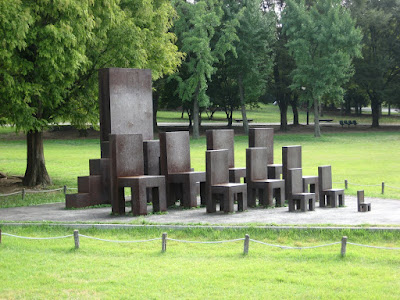


In the early 1980s, Korea was a burgeoning economic powerhouse, a culture rich in tradition, and a benign dictatorship teetering on the edge of collapse. While many outcomes were possible, even equally likely, I think the world is lucky that things turned out the way they did.
Of course, we all know the dramatic story of Korea's economic birth in the 1960s and its rise to become one of the best known international consumer "brands" in the 1990s. We know, too, the historic pro-democracy protests around the time of the XXIVth Olympiad that led to the country's establishment of an imperfect, but thriving, democracy. I remember watching newsstories back home, on a nascent cable channel called CNN--like most people, wondering if the 4-year games were in jeopardy (remember the US boycotted the 1980 games, and the Soviets returned the favor in 1984)! As I say, we are lucky things turned out as they did.
One story that I have not heard until now is how the Olympic Games helped to write a new chapter in Korea's ancient history! Mongchontoseong is a sixth century earthen fortification of the Baekje 백제 Kingdom, which was driven away from the Han River by the Goguryeo 고구려 who moved south from Manchuria in the 600s CE. This is well-established in documents known to historians (mouse over photos for labels, click for large version). But less known is that its artifacts were uncovered by the Olympic building process.


It is no coincidence that this historic site rubs shoulders with the velodrome, Olympic pool, fencing gymnasium, etc--the coincidence was they chose the site in the first place. Only during excavations and preparations for the Games was it discovered that on this site lay Mongchontoseong of the Baekje Period.
Today's "Olympic Park" fits the arena venues (swimming, fencing, biking, tennis, gymnastics), the Peace Plaza, the stream and the Sculpture Park in and around the remnants of the Baekje fortress and its moat. Mongchon fortress was discovered and excavated during Korea's preparations for the 1988 Seoul Olympic Games. What we have today is mostly a lot of mounds and ridges that of themselves say little to the ordinary viewer--but to the archaeologist with a wider view, the fortress becomes self-evident.



The museum itself is a small affair, though it is attended, or was today, by an ebullient fellow with good English and firm command of the facts--enough that he was willing to admit he didn't know what something was when I asked him about one of the scale models! Still, he had his axe to grind, which was mostly about how the relics in the museum demonstrate that Korea gave its culture to Japan, rather than the other way round. This I find to be pretty common--all part of Korea's "han" syndrome, the I have an inferiority complex which explains why I am such a braggart thing.
Below are photos snapped somewhat surreptitiously of: first, a seven-bladed sword; second, some burial artifacts of a Baekje king from the Buyeo period, including a pig/haetae/whatever creature that guarded the tomb; and third, some Baekje period pottery--no museum blog post is complete without a picture of some pottery.



Finally, here are two photos from the museum grounds, I really have no idea what they represent:












No comments:
Post a Comment